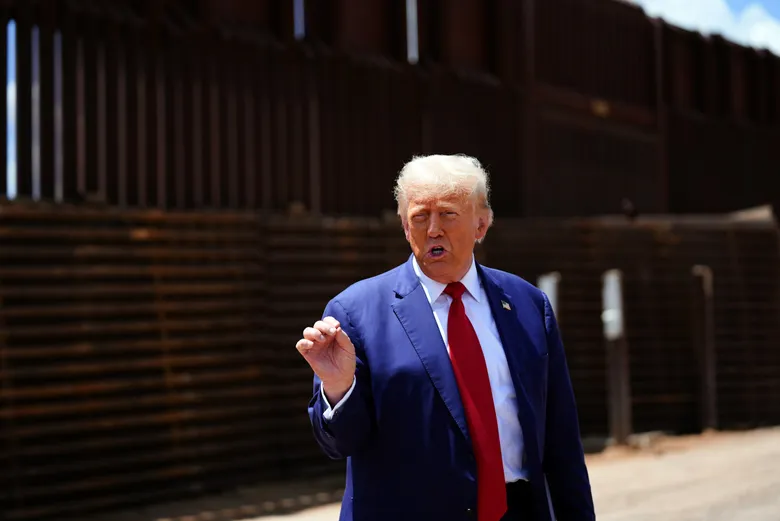Deportation is the sword that Donald Trump is holding, the return of Trump to the White House has sent ripples of anxiety across the immigrant community in the United States, particularly for the 7,25,000 undocumented Indians living in the country. While world leaders flooded social media with congratulatory messages following Trump’s inauguration, undocumented immigrants are bracing for what may be one of the most aggressive crackdowns on illegal immigration in modern history.
A Return to Hardline Immigration Policies
In his inaugural address, Trump wasted no time in reaffirming his hardline stance on immigration. Promising swift and decisive action, he announced a series of executive orders aimed at curbing illegal immigration. “We will stop illegal immigration once and for all,” he declared. “We will not be invaded, we will not be occupied, we will not be overrun, we will not be conquered.” His rhetoric, steeped in nationalism, signals a return to his “America First” agenda, with an intensified focus on securing the nation’s borders.
Indians in the Crosshairs
Indians make up the third-largest group of undocumented immigrants in the U.S., following Mexico and El Salvador. According to a recent report, approximately 7,25,000 Indians live in the U.S. without legal status. While Trump’s aggressive deportation plans may initially target those with criminal charges or prior deportation orders, the ripple effect of these policies is likely to impact the broader undocumented population.
A Herculean Task
Deporting millions of undocumented immigrants is a logistical nightmare. Even the subset of 6,55,000 individuals with criminal charges or convictions will require an extensive operation, involving at least 150 flights. For the 1.4 million individuals who have already been served deportation orders, the scale of the task grows exponentially, demanding over 5,000 flights.
The sheer complexity of these operations raises questions about their feasibility, especially considering the financial and administrative burden they would impose on the federal government.

Fear and Uncertainty
Beyond the logistical challenges, the human toll of these policies is immense. More than six million immigrants are living in limbo, their deportations pending or paused due to ongoing legal proceedings.
This includes, approximately 2.6 million asylum seekers fleeing violence and persecution.
1.1 million individuals with Temporary Protected Status (TPS).
8,50,000 people on humanitarian parole from conflict zones like Afghanistan and Ukraine.
5,40,000 DACA recipients, brought to the U.S. as children and protected under the Deferred Action for Childhood Arrivals program.
For these individuals, Trump’s return to power represents a precarious future. The fear of family separations, job losses, and abrupt deportations looms large, threatening the stability of countless lives.
Border Security. A Top Priority
The U.S.-Mexico border is at the heart of Trump’s immigration agenda. His plans include declaring illegal immigration a national emergency, ramping up border wall construction, and deploying military troops to bolster security. Trump’s reintroduction of his “Remain in Mexico” policy, which forces asylum seekers to wait in Mexico while their claims are processed, shows his intent to minimize the number of immigrants crossing the border.
He also criticized the previous administration, stating, that the last four years have created an unconscionable risk to public safety, public health, and the national security of the United States due to the Biden administration border policies.
Sweeping Changes to Asylum and Immigration Programs
Trump’s agenda doesn’t stop at the border. His administration plans to issue a proclamation to block all asylum claims at the U.S.-Mexico border. This move is expected to face fierce resistance from immigration advocates and legal challenges from organizations like the American Civil Liberties Union (ACLU).
In addition, Trump intends to suspend the U.S. refugee resettlement program for at least four months, pending a security review to determine whether travelers from certain countries should face a travel ban. Kristi Noem, Trump’s pick for Homeland Security secretary, echoed this stance, vowing to dismantle Biden-era programs that have allowed hundreds of thousands of migrants to enter the U.S. on a temporary basis.

Designating Cartels as Terrorist Organizations
One of the most controversial aspects of Trump’s immigration plan is his intention to designate criminal cartels as foreign terrorist organizations. According to Trump, this would enable federal and state law enforcement agencies to leverage the “full and immense power” of the law to dismantle criminal networks.
Trump has declared that as commander-in-chief, I have no higher responsibility than to defend our country from threats and invasions, and that is exactly what I am going to do.
Economic and Social Implications
While Trump’s tough talk resonates with his base, the broader implications of his policies are complex and potentially disruptive. The U.S. agricultural sector, which heavily relies on immigrant labor, is already expressing concerns. Farm industry groups have urged the administration to consider the economic impact of mass deportations, warning that such actions could cripple the sector.
Trump’s hardline approach is expected to face significant legal and political pushback. During his first term, many of his immigration policies were stalled by lawsuits from states like California and advocacy groups like the ACLU. These organizations are already preparing to challenge his new policies, which they view as extreme and unconstitutional.
Moreover, a December Reuters/Ipsos poll revealed that while Americans have become less welcoming toward undocumented immigrants, there remains widespread unease about measures like detention camps and large-scale deportations.
However, if one were to look closely, Trump’s immigration policies are not just a domestic issue; they carry significant international ramifications. The prospect of mass deportations could strain diplomatic relations with countries like India, Mexico, and El Salvador, which may struggle to reintegrate returning nationals. Additionally, these policies risk tarnishing the U.S.’s image as a land of opportunity, potentially deterring skilled immigrants and asylum seekers in the future.
The Last Bit
Trump’s immigration agenda is set to reshape the national discourse on immigration. For some, it represents a necessary step to restore order and security. For others, it’s a harsh, divisive approach that threatens to erode the country’s values.
As Trump begins his second term, the sword of deportation hangs precariously over the heads of 7,50,000 Indians and millions of others. While the logistical challenges of mass deportations are daunting, the human cost is immeasurable.
Will this aggressive stance on immigration lead to a more secure nation, or will it deepen divisions and erode the foundational ideals of America as a haven for the hopeful and the oppressed?
For now, millions can do little but hold their breath and hope for a more compassionate approach.















